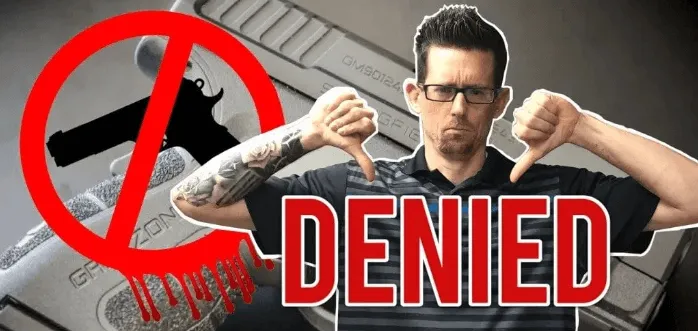Florida Concealed Carry Law Blog
Follow Us for News, Tips , Tricks, Guns Gear and Real Life Stories

How to Fly With a Gun
What's Up Sheepdogs? Ryan here with Tampa Carry.
I know this sounds crazy, but flying with a firearm is not only legal but it's also easy if you follow the steps found in this guide.
How to Fly With a Gun in 3 Steps
Step 1: The Federal Law
First you need to understand the TSA's policy for transporting a firearm on an airplane. The firearm must be unloaded and placed into a hard plastic or metal case that cannot be easily pried open.
The case must be locked with a combination or key lock. It's also important to note that you must have locks for each place your gun case allows them.
Firearm magazines, loaded or unloaded, and ammunition must be included with the hard case containing your unloaded firearm. Section 49 of the Code of Federal Regulations 175.10 states that the ammunition must be packed in the original packaging, or it must be in a case specifically designed to hold ammunition.
Surprisingly, you can travel with up to 11 pounds of ammunition. I'm not sure why or how they came up with that number, but that's the rule.
Step 2: Your Airline's PolicySecond you need to research the firearm transportation policies for your airline.
Sometimes your airline's policies will be stricter than the TSA guidelines.
I also recommend that you print a copy of the TSA's firearm transportation policy and your airline's policy before heading to the airport.
I have heard countless stories of airline workers not understanding their policies and calling airport police when someone declares that they have a firearm in their luggage.
Here you can view the American Airlines firearms policy
Step 3: Laws of Your Final DestinationFinally, you need to research the firearm and ammunition laws of your final destination.
If you have a Florida concealed weapons permit and you're traveling to a reciprocal state, you know that the process will be easy.
However, if your final destination is not a reciprocal state, you need to exercise a lot of caution. California, Illinois, New York, New Jersey, Connecticut, and Massachusetts have some of the strictest firearms laws in the nation and love to issue weapon violation fines.
Whichever state you're traveling to, make sure you complete your research. Don't wing it; you need to know the laws before your trip begins. If you're traveling outside of the United States, you must research the firearm importation laws of the country you’re going to visit, as well as the U.S. Customs and Border Protection guidelines for the temporary exportation of a firearm.
Understanding The ProcessWhen you arrive at the airport, you must immediately declare your firearm to your airline or TSA personnel, whichever comes first.
The way I do this is by asking for a firearms declaration card. This is a subtle way of informing the individual that I have a firearm. You want to avoid saying something like "I have a gun.” This could cause confusion.
Once you declare your firearm and receive your boarding pass, you will be escorted to a TSA inspection area where one of two things will happen.
Either a TSA agent will run your bag through a metal detector and give you the all-clear or the TSA agent will request your keys to unlock and physically inspect your firearm. They will run chemical swabs and ensure the firearm is being transported according to federal law. Once the inspection is complete, you will be free to leave.
I'm sure you can understand it's important to give yourself extra time so you don't miss your flight. After your flight, you will pick up your luggage from the baggage service office of your airline. Here they will verify your ID and release the firearm to you. All in all, the process is pretty simple if you're prepared.
As you're planning for your trip, it's imperative to research the firearm laws for each state you will enter. Thankfully, there are several websites available to assist you with this.NRA-LIA.com - This is the NRA's legal website. It provides an overview of firearm laws, but the information is not very detailed.
HandgunLaw.us - This is a private website that provides detailed information on firearm law. The site is of inferior quality, but the data appears to be good.
Research You Must CompleteHere is a list of questions you must find the answers to before entering a new state:
What are the requirements for transporting a firearm through this state?
Is my firearm lawful to possess in this state?
Is hollow-point ammunition allowed in this state?
In what places am I prohibited from carrying concealed?
Can I carry in a restaurant that serves alcohol?
What are the state requirements if stopped by the police?
What firearms or weapons can I lawfully carry concealed?
What are the laws on the use of deadly force?
Do I have to obey "no guns allowed" signs at a business?
If traveling with multiple firearms, how do non-concealed firearms need to be stored in my vehicle?
Does this state have a “stand your ground” provision? What are the rules?
Does this state have a castle doctrine? What are the rules?
Does this state have a retreat rule?
Does this state have a preemption law?
Conclusion
Flying with a firearm is extremely easy and legal if you follow the three steps outlined in this article.
First, you need to understand the federal law
Second, you need to research your airlines policy
Finally, you need to understand the laws of your final destination
As most of you know I carry my firearm 100% of the time I am legally allowed to and this includes when I travel...
That's all I have for today. So until next time keep training and stay safe...Talk to you soon,
Ryan G. Thomas
P.S. You’re one step away from getting your Florida concealed carry permit….FAST & EASY…
And for a limited time you can watch the concealed carry course online for free... Click here to get started...
Don't Miss a Thing!
Get Notified When We Post a New Article
Most Popular Concealed Carry Articles

Florida Private Gun Sales Rules

Am I Eligible For A Florida Concealed Carry Permit?
Get FREE Access To The Florida Concealed Carry Masterclass™
Join over 60,000 Floridians Who Chose Tampa Carry To Get Their Florida Concealed Carry Permit
All rights Reserved. Copyright 2026 Tampa Carry



